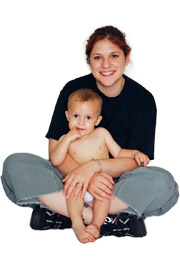- Statistics on mothers
- Where do Australian women have their babies?
- How common are the different types of delivery?
- What is the average age of Australian mothers?
- How many women having babies are of Aboriginal or Torres Strait Islander origin?
- How many women smoke while they are pregnant?
- How common are multiple births?
- How commonly is labour induced?
- How long do women stay in hospital after having their baby?
- How many women give birth in private versus public hospitals?
- How long does labour take on average?
- How many children does the average Australian women give birth to?
Statistics on mothers
 Where do Australian women have their babies?
Where do Australian women have their babies?
In Australia, 97.5% of women give birth in hospitals. Almost 2% of women choose family birth centres, which are run by midwives. Planned homebirths, or unexpected delivery on the way to the hospital or other settings, make up the remaining 0.6% of births.
How common are the different types of delivery?
70% of Australian women have vaginal births, while 30% have caesarean deliveries. Of all women delivering babies in Australia:
- 58.1% had a spontaneous vaginal birth;
- 0.4% had a vaginal breech birth (baby is delivered bottom or feet first rather than head first);
- 3.5% were delivered using forceps; and
- 7.2% required vacuum extractions.
What is the average age of Australian mothers?

The average age of Australian women having their first baby is 28.2 years. 14% of women having their first baby were aged 35 years or older. In 1997, 8.3% of first births were to women aged 35 years or older.
How many women having babies are of Aboriginal or Torres Strait Islander origin?
Aboriginal and Torres Strait Islander women made up 3.7% of all mothers giving birth in 2006.
How many women smoke while they are pregnant?
17.3% of pregnant women in Australia report that they smoked at some stage during their pregnancy.
How common are multiple births?
1.7% of pregnant women in Australia have a multiple pregnancy (from 20 weeks gestation onwards). Of the 4,622 multiple pregnancies in a single year, 4,515 were twin pregnancies, 102 were triplet pregnancies and five were quadruplet pregnancies.
How commonly is labour induced?
A quarter of all pregnant women in Australia (25.1%) have their labour induced. The most common reason for induction is reported as prolonged pregnancy.
How long do women stay in hospital after having their baby?
Women who have a vaginal delivery stay in hospital for an average of 3 days. Women who have a caesarean section stay in hospital for an average of 5 days.
Book your health appointments online
Find and instantly book your next health appointment with Healthengine
How many women give birth in private versus public hospitals?

Of the women cared for by a private obstetrician, 58% of women having their first babies delivered in a private hospital, while 55% of women who had delivered before had their baby in a private hospital. The remaining women delivered in a public hospital under the care of a private obstetrician.
How long does labour take on average?
The entire process of labour and vaginal birth takes an average of 13 hours in women giving birth for the first time (nulliparous), and 8 hours in women who have given birth before (multiparous). However, the exact duration varies a great deal from one woman to another.
First stage of labour
- Takes on average 8 hours in a nulliparous woman and 4 hours in a multiparous woman. If the first stage lasts longer than 12 hours then this may suggest failure to progress. 18 hours of first stage is considered ‘prolonged’;
- The latent phase of first stage tends to be slow, lasting an average of around 6 hours for a first baby, and 4 to 5 hours for women who have had babies before, though it may last up to 8 to 12 hours;
- The active phase of first stage should last around 6 hours in nulliparous women (the cervix should dilate at least 1cm an hour). The active phase lasts around 3 hours in multiparous women (the cervix dilates more quickly, around 2cm/hr).
Second stage of labour
- In a nulliparous woman it takes on average 40 mins for the pushing phase, and about 20 mins in a multiparous woman.
- 1.5-2 hours of second stage is considered ‘prolonged’.
Third stage of labour
- Active management of third stage is faster (around 5-7 minutes).
- Physiological management of third stage may take up to 30 minutes.
 |
For more information, see Stages of Labour. |
How many children does the average Australian women give birth to?

- 41.6% were having their first baby;
- 33.4% were having their second baby;
- 15.4% were having their third baby;
- 5.6% were having their fourth baby;
- 3.8% were having their fifth baby;
- 0.2% were having their sixth or more baby.
Statistics on babies
Is it more common to give birth to a boy or a girl?
In all states and territories, it is more common to give birth to a boy than a girl. Boys accounted for 51.5% of all live births nationally.
How many babies are born early or late?
8.2% of Australian babies are born at less than 37 weeks gestation (preterm), compared with 7.3% in 1997.
Of babies born in a single year, 0.8% were born at 20-27 weeks, 0.7% were born at 28-31 weeks, and 5.8% were born at 32-36 weeks. 1.2% of babies were born post term (greater than 42 weeks gestation).
 How many babies are born with a low birth weight?
How many babies are born with a low birth weight?
6.4% of babies born alive weigh less than 2,500 grams, which is considered to be low birth weight.
How many babies require specialist medical care at birth?
14. 9% of liveborn babies require admission to neonatal intensive care or a special care nursery.
How common are stillbirths?
Of the 282,169 babies born in Australia in a single year, 280,078 were born alive, and 2,091 were stillborn. The death rate prior to birth was 7.4 per 1,000 births, and the death rate up to 28 days after birth was 3.0 per 1,000 live births. The total perinatal death rate in Australia was 10.3 per 1,000 births (around 1%). The most common reason these babies died was due to congenital abnormalities.
More information
 |
For information on stages of labour, various birthing types and other information related to giving birth, see Birth. |
References
- Laws P, Hilder L. Perinatal statistcs series no. 22: Australia’s mothers and babies 2006 [online]. Bruce, ACT: Australian Institute of Health and Welfare, Australian Government; December 2008 [cited 19 September 2009]. Available from: URL link
- Roberts CL, Tracy S, Peat B. Rates for obstetric intervention among private and public patients in Australia: Population based descriptive study. BMJ. 2000;321(7254):137-41. [Abstract | Full text]
- Symonds E, Symonds I. Essential Obstetrics and Gynaecology (4th edition). Oxford: Churchill Livingstone; 2003. [Publisher]
- Enkin M, Keirse M, Neilson J, et al. A Guide to Effective Care in Pregnancy and Childbirth (3rd edition). Oxford: Oxford University Press; 2000. [Publisher]
All content and media on the HealthEngine Blog is created and published online for informational purposes only. It is not intended to be a substitute for professional medical advice and should not be relied on as health or personal advice. Always seek the guidance of your doctor or other qualified health professional with any questions you may have regarding your health or a medical condition. Never disregard the advice of a medical professional, or delay in seeking it because of something you have read on this Website. If you think you may have a medical emergency, call your doctor, go to the nearest hospital emergency department, or call the emergency services immediately.


 Where do Australian women have their babies?
Where do Australian women have their babies? How many babies are born with a low birth weight?
How many babies are born with a low birth weight?





